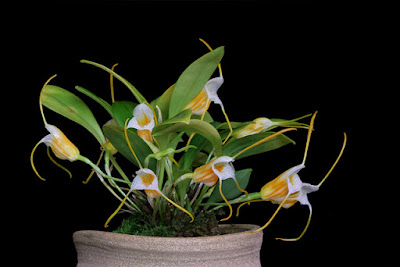Masdevallia ampullacea is found in Ecuador and Peru. It occurs occasionally in the wet forests of southeastern Ecuador at altitudes ranging from 600 to 2400 meters above sea level.
Masdevallia ampullacea also called as The Flask Masdevallia, The Bottle Masdevallia, is a species of the genus Masdevallia. This species was described by Carlyle August Luer & Angel Andreetta in 1979. The name from this species derives from the Latin ampullaceus, meaning like a flask or bottle, which refers to the shape of the sepaline tube.
IDENTIFY MASDEVALLIA AMPULLACEA ORCHID PLANT
Masdevallia ampullacea is found in Ecuador and Peru. The species was first discovered by Father Angel Andreetta of Cuenca, Ecuador, in August 1978. It occurs occasionally in the wet forests of southeastern Ecuador at altitudes ranging from 600 to 2400 meters above sea level.
The Flask Masdevallia is a miniature to small sized, robust, warm to cool growing epiphyte with blackish, erect, slender ramicauls enveloped basally by 2 to 3 tubular sheaths carrying a single, apical, erect, coriaceous, elliptical, subacute, up to 12 cm long leaf that is narrowly cuneate into the petiolate base.
The Bottle Masdevallia blooms in the fall and winter on a slender, suberect, 3 to 4 cm long, single flowered inflorescence arising from low on the ramicaul with a bract near the base and a tubular floral bract that has the flower held below the leaves. The 5 to 7.6 cm flowers, characterized by white and yellow-orange sepaline tubes, with varying amounts of orange on the exterior, and orange-yellow erect to reflexed tails. In cultivation, if can guarantee optimal cultural conditions, the plant can flower at any time of the year.
MASDEVALLIA AMPULLACEA ORCHID PLANT CARE AND CULTURE
Cultural information should only be used as a guide, and should be to be adapted to suit you. Your physical location; where you grow your plants, how much time you have to devote to their care, and many other factors, will need to be taken into account. Only then can you decide on the cultural methods that best suit you and your plants.
Light:
Masdevallia ampullacea needs a light level of 8000-15000 lux. The direct sun must be shielded. The leaves should be a light green, not yellowish (too much light) or dark green (too little light).
Temperature:
The ideal temperature to grow The Flask Masdevallia is 28-30 ° C in daytime and nighttime ranging 17-19 ° C. Ensure 6-12°C day/night difference to aid flower formation.
Humidity:
The Bottle Masdevallia do best with 70 - 90% humidity but when mature will grow and bloom, although more slowly, in somewhat lower humidity. Use humidifier to raise humidity - humidity pans and misting minimally effective. Enclosing plant growing areas is effective but ensure fresh air and air movement to avoid mold and rot.
Substrate, growing media and repotting:
Masdevallia ampullacea is best to grow in a pot using sphagnum fiber coarse as a substrate (with or without the addition of perlite). As a vase it is better to use a plastic basket: in this case there is no risk of water stagnation. However, if the environment is not sufficiently humid, a closed plastic pot can be used to avoid too rapid drying of the substrate.
Repot annually, preferably in the autumn, to ensure that the medium does not break down. Remove old medium if it is loose or breaking down, rotting roots and any growths without leaves; use a plastic pot that will allow for no more than 1 cm on all sides of the plant.
Watering:
The roots of this orchid should be moist at all times. Ideally, the plant is watered each morning, and has dried to dampness by evening. Do not use water softened in salt-consuming water softeners. Low mineral content water is essential, such as naturally soft water or rain water. If hard water must be used, water very heavily to flush minerals.
Fertilizer:
The Flask Masdevallia is fertilized every 3-4 weeks with 1/4 of the dose indicated on the bottle of a special liquid fertilizer for orchids which is added to the wetting water.
Rest period:
Masdevallia ampullacea does not needs a period of rest. The given cultivation conditions should maintain throughout the year.















COMMENTS